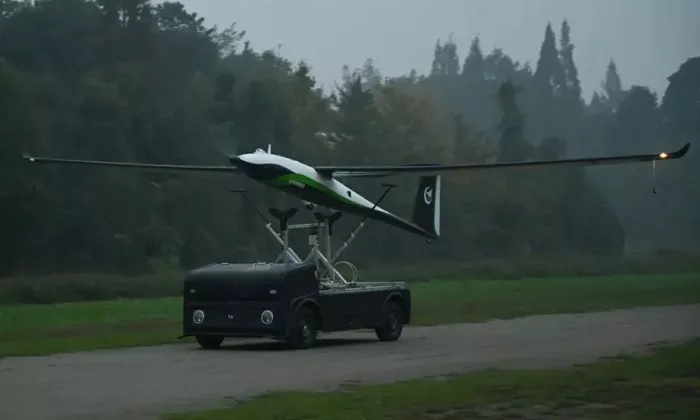A 50-kilogram hydrogen-powered unmanned aerial vehicle (UAV) developed by China recently completed a continuous 30-hour flight, setting a new domestic record for similar aircraft and reaching a leading position globally in terms of endurance.
The drone, a joint development between Chengdu Aircraft Industrial Group Co (CAIG) under the Aviation Industry Corporation of China (AVIC) and Tsinghua University, achieved a breakthrough in integrating flight, propulsion, and control systems, specifically designed for hydrogen fuel cells, according to AVIC.
The aircraft used an innovative autonomous release method during takeoff, combining an unmanned ground vehicle and the UAV. This system successfully operated under non-standard runway conditions, proving its capabilities.
Equipped with an electro-optical payload, the drone is capable of performing ground patrols and surveillance. Additionally, it uses a 5G onboard module to transmit real-time telemetry and mission images to a remote platform, allowing for dynamic remote monitoring.
This model, combining real-time data and decision-making, shows great potential in various areas such as emergency communications, environmental monitoring, and border patrol. During disaster relief efforts, drones can stay airborne for long periods, providing live images of affected areas. They can also aid in smart city management, automatically detecting violations using AI algorithms and triggering responses.
Hydrogen-powered drones offer advantages over traditional lithium battery-powered ones. They have higher energy density, longer flight times, and zero carbon emissions, making them ideal for green aviation. The 30-hour flight capability expands the operational range of drones and allows for more complex missions.
The design of the hydrogen fuel cells used in these drones differs from those used in cars, focusing on lightweight, high energy density, and performance in ultra-low temperatures, as explained by Shi Xin, an expert from the State Key Laboratory of Catalysis at the Dalian Institute of Chemical Physics.
Several global companies, including South Korea’s Doosan Mobility Innovation, the UK’s ISS Aerospace, Japan’s Drone Works, and Israel’s Heven drones, are developing hydrogen-powered UAVs. The US company AeroVironment built and tested the world’s first liquid hydrogen-powered drone in 2005.
Chinese companies are now entering the hydrogen drone market, driven by its promising prospects. CAIG believes that this hydrogen-powered UAV will expand the use of drones in the low-altitude economy and help advance green aviation and new business models.


